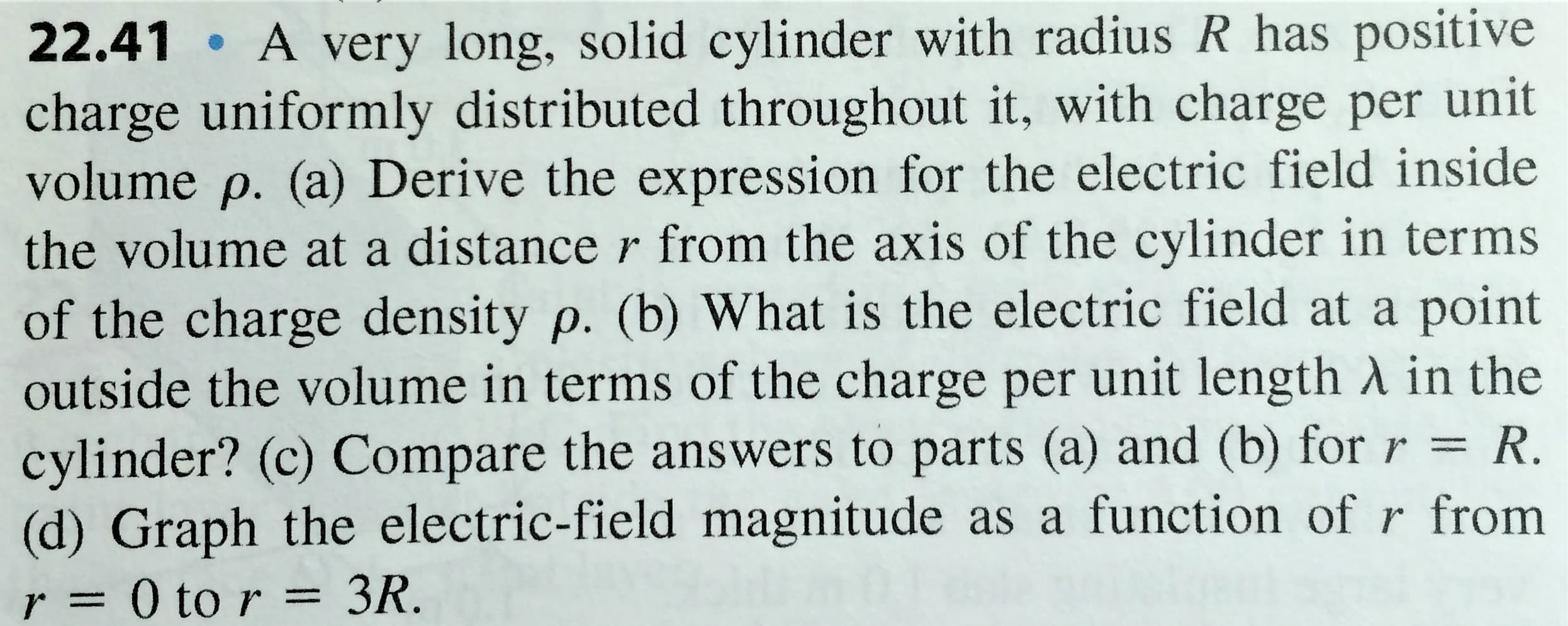22.41 A very long, solid cylinder with radius R has positive charge uniformly distributed throughout it, with charge per unit volume p. (a) Derive the expression for the electric field inside the volume at a distance r from the axis of the cylinder in terms of the charge density p. (b) What is the electric field at a point outside the volume in terms of the charge per unit length A in the cylinder? (c) Compare the answers to parts (a) and (b) forr = R. (d) Graph the electric-field magnitude as a function of r from 3R. r= 0 to r =
22.41 A very long, solid cylinder with radius R has positive charge uniformly distributed throughout it, with charge per unit volume p. (a) Derive the expression for the electric field inside the volume at a distance r from the axis of the cylinder in terms of the charge density p. (b) What is the electric field at a point outside the volume in terms of the charge per unit length A in the cylinder? (c) Compare the answers to parts (a) and (b) forr = R. (d) Graph the electric-field magnitude as a function of r from 3R. r= 0 to r =
Physics for Scientists and Engineers: Foundations and Connections
1st Edition
ISBN:9781133939146
Author:Katz, Debora M.
Publisher:Katz, Debora M.
Chapter25: Gauss’s Law
Section: Chapter Questions
Problem 48PQ
Related questions
Question
(Question in image)
Hint:To check your answers to parts (a) and (b), a correct answer to part (c) should allow you to further write ρ = Q /LπR2, where Q is the total charge on the cylinder and L is the length of the cylinder.

Transcribed Image Text:22.41 A very long, solid cylinder with radius R has positive
charge uniformly distributed throughout it, with charge per unit
volume p. (a) Derive the expression for the electric field inside
the volume at a distance r from the axis of the cylinder in terms
of the charge density p. (b) What is the electric field at a point
outside the volume in terms of the charge per unit length A in the
cylinder? (c) Compare the answers to parts (a) and (b) forr = R.
(d) Graph the electric-field magnitude as a function of r from
3R.
r= 0 to r =
Expert Solution
This question has been solved!
Explore an expertly crafted, step-by-step solution for a thorough understanding of key concepts.
This is a popular solution!
Trending now
This is a popular solution!
Step by step
Solved in 5 steps with 4 images

Knowledge Booster
Learn more about
Need a deep-dive on the concept behind this application? Look no further. Learn more about this topic, physics and related others by exploring similar questions and additional content below.Recommended textbooks for you

Physics for Scientists and Engineers: Foundations…
Physics
ISBN:
9781133939146
Author:
Katz, Debora M.
Publisher:
Cengage Learning

Physics for Scientists and Engineers: Foundations…
Physics
ISBN:
9781133939146
Author:
Katz, Debora M.
Publisher:
Cengage Learning